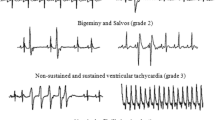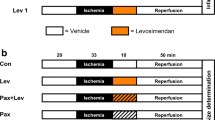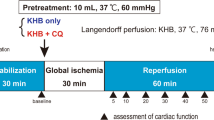Abstract
Purpose
The present study was carried out to determine the cardioprotective effects of KB-R7943 (KBR), a selective inhibitor of the reverse mode of Na+/Ca2+ exchanger (NCX), on stunned myocardium in anesthetized dogs.
Methods
The dogs were allocated to one of three groups (n = 7 for each group), and received drug vehicle (group C), low-dose KBR (5 mg·kg−1 i.v.) (group L) or high-dose KBR (10 mg·kg−1 i.v.) (group H) at 15 min before left anterior descending coronary artery (LAD) occlusion. Stunned myocardium was produced by 15-min occlusion of LAD and 90-min reperfusion in all dogs. Regional myocardial contractility was evaluated with segment shortening (%SS).
Results
Recovery of %SS at 90 min after reperfusion was significantly improved in group H (70.8% ± 3.9% of baseline), whereas the recovery was poor in groups C and L (34.3% ± 2.8% and 36.4% ± 5.4% of baseline, respectively). Regional myocardial blood flow showed no significant difference among groups. KBR had no effect on coronary or systemic hemodynamics.
Conclusion
The results show that preischemic administration of high-dose KBR markedly improves myocardial contractile dysfunction after ischemia-reperfusion in anesthetized dogs, indicating that KBR protects myocardium against the ischemia-reperfusion injury in vivo.
Similar content being viewed by others
Author information
Authors and Affiliations
About this article
Cite this article
Yoshitomi, O., Akiyama, D., Hara, T. et al. Cardioprotective effects of KB-R7943, a novel inhibitor of Na+/Ca2+ exchanger, on stunned myocardium in anesthetized dogs. J Anesth 19, 124–130 (2005). https://doi.org/10.1007/s00540-004-0290-0
Received:
Accepted:
Issue Date:
DOI: https://doi.org/10.1007/s00540-004-0290-0




